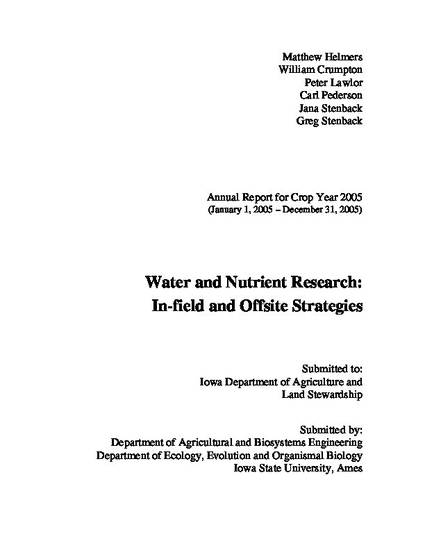
Unpublished Paper
Water and Nutrient Research: In-field and Offsite Strategies—2005 Annual Report
Agricultural and Biosystems Engineering Technical Reports and White Papers
Document Type
Report
Publication Date
1-1-2006
Granting or Sponsoring Agency
Iowa Department of Agriculture and Land Stewardship
Disciplines
Abstract
Much of Iowa is characterized by relatively flat, poorly-drained soils which, with extensive artificial subsurface drainage, have became some of the most valuable, productive lands in the State. In 2002, the average land value for the 22-county area making up most of the Des Moines Lobe was $2,436 an acre, and 80.5% of that area was in row-crops (42.9% in corn and 37.6% soybeans). However, this drained land has also become a source of significant NO3 loss because of the changes in land-use and hydrology brought about by tile drainage. While surface runoff is decreased with subsurface drainage (resulting in decreased losses of sediment, ammonium-nitrogen, phosphorus, pesticides and micro-organisms), subsurface flow and leaching losses of NO3 are increased. This is due mostly to an increase in volume and the “short-circuiting” of subsurface flow, but also in part to the increased aeration of organic-rich soils with potentially increased mineralization and formation of NO3 (and less denitrification) in the soil profile.
The problem of excess nutrient loads can probably be ameliorated by a combination of in field and off site practices, but the limitations and appropriateness of alternative practices must be understood and outcomes must be measurable. Promising in field practices include nutrient management, drainage management, and alternative cropping systems. Nitrate-removal wetlands are a proven edge-of-field practice for reducing nitrate loads to downstream water bodies and are a particularly promising approach in tile drained landscapes. Strategies are needed that can achieve measurable and predictable reductions in the export of nutrients from tile drained landscapes. The principal objectives of this project are (1) to evaluate the performance of nutrient management, drainage management, and alternative cropping systems with respect to profitability and export of water and nutrients (nitrate-nitrogen and total phosphorus) from tile drained systems and (2) to evaluate the performance of nitrate-removal wetlands in reducing nitrate export from tile drained systems.
This annual report describes activities related to objectives 1 and 2 along with outreach activities that were directly related to this project. Results for crop year 2005 are described.
Language
en
File Format
application/pdf
Citation Information
Matthew J. Helmers, William G. Crumpton, Peter Lawlor, Carl H. Pederson, et al.. "Water and Nutrient Research: In-field and Offsite Strategies—2005 Annual Report" (2006) Available at: http://works.bepress.com/matthew_helmers/26/
